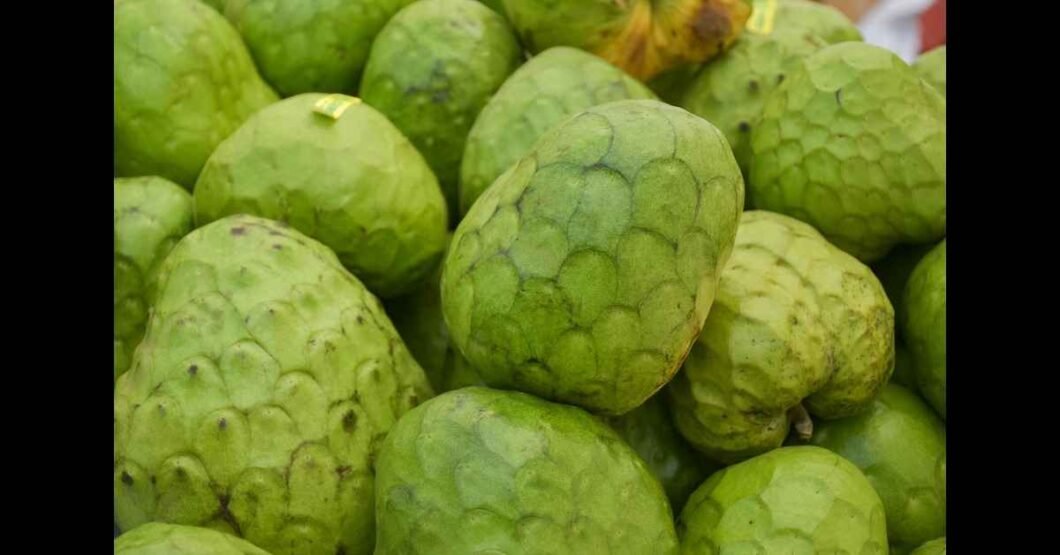Introduction
Cherimoya, often referred to as the custard apple or ice cream fruit, is a luscious tropical fruit that has received both nutritional and culinary attention across the world. Its flavor has been noted as being a combination of banana, pineapple and strawberry and this heart shaped piece of fruit is exotic and beneficial at the same time. Irrespective of its history, cherimoya has been downplayed in other regions of the globe.
As most of the attention in the world food market is paid to superfoods, organic nutrition, and plant based wellness, the cherimoya is becoming relevant due to its high vitamin presence, antioxidant levels and natural sweetness in 2025.
Are you a health freak, a chef, or just someone interested in nutrient-rich fruits? Then you are at the right place because this article explores in depth the origins, nutrition facts, application and methods of farming cherimoya, among other related information.
The benefit of cherimoya goes beyond its flavor, cleaning heart health and digestion as well as contributing to immunity and behind the scenes this tasting pleasure leaves a decadent feeling. Lemons are among the many edible delights in the nucleus of the food industry.
What Is Cherimoya? Defining the Fruit
Cherimoya (Annona cherimola), one of the Annonaceae family members, is a soft, green, scaly fruit, known for its perception in the world as having a sweet, custard-like flavor. It originally comes from the warm subtropical climates and is native to the Andes mountain range of South America.
Common Names:
- Though a different species, not quite a Dakona but ANOTHER custard apple
- Chirimoya (Spanish)
- Annona (scientific genus)
Physical Characteristics:
- Heart or conical shape
- The green scaly skin
- White creamy pulp on the inside
- Big black seeds (inedible)
| Attribute | Description |
| Flavor | Banana, pineapple, papaya, pear |
| Texture | Creamy, custard-like |
| Size | 10–20 cm in length |
| Weight | 200g to 500g per fruit |
| Harvest Season | Late winter to early spring (varies by region) |
Cherimoya is usually eaten raw, but it is also used in drinks, ice creams, smoothies, and sweets.
Historical and Cultural Origins of Cherimoya
Cherimoya cherries are of pre Columbian origin and were raised even during Inca times in Peru and Ecuador. It is a popular food of the native cultures, which was highly appreciated because of its medicinal properties along with its flavour.
Global Expansion:
- South America: South America continues to produce a lot of it in Peru, Ecuador, Colombia and Chile.
- Spain: Andalusia: Grown in Andalusia, where the Denomination of Origin, cultivated since time immemorial, or Chirimoya de la Costa Tropical de Granada-Malaga, exists.
- California/Hawaii: Grows in USDA zones 9-11
- Asia: Restricted areas in India, Thailand, and Vietnam
The use of cherimoya began to manifest itself in those conditions, as a result of which it is also spread by its suitable climatic conditions in coastal mountains.
Nutritional Value and Health Benefits of Cherimoya
Unlike other fruit, it’s loaded with the nutrient-to-calorie ratio, plus an awesome lineup of natural compounds.
Nutritional Breakdown (per 100 g serving):
| Nutrient | Amount |
| Calories | 75 kcal |
| Carbohydrates | 17.7 g |
| Protein | 1.6 g |
| Fiber | 3.0 g |
| Vitamin C | 20 mg (33% DV) |
| Vitamin B6 | 0.25 mg |
| Potassium | 287 mg |
Related Main Health Advantages:
- Promotes immunity (rich in Vitamin C)
- Accelerates the bowel movement (rich in dietary fiber)
- Is beneficial to your heart (potassium and magnesium)
- Contain annonaceous acetogenins: Have been researched towards being used to treat inflammations and cancer
Growing Cherimoya: Climate, Cultivation & Harvesting
Cherimoya can grow easily provided the correct climate and conditions are present. The strength and medium height nature of the tree qualify it to be a part of home gardens and small orchard systems.
Growing Conditions:
- Optimal temperature: 18-25°C (65-77°F)
- Altitude: 700-2 000 meters (sea level)
- Soil: Deep, rich, moist, loamy soil with pH 6.5-7.6
- Light: Full sun to part shade
| Step | Timing (Northern Hemisphere) |
| Planting | Spring |
| Flowering | Late spring |
| Hand Pollination | Early-mid summer |
| Harvest | Autumn–Winter |
Pollination Facts:
Cherimoya is mainly pollinated by hand in non-native areas. The flowers are protandrous, that is, the male and female organs mature independently of each other, the male organs reaching maturity first and natural pollination is difficult here.
Culinary Uses and Preparation Methods
Cherimoya fruit has one of the broadest applications of cooking in the tropical world.
What to Do with a Cherimoya:
- Best option: With half, eaten with a spoon Adam
- In Smoothies: Combines well with almond milk and banana
- sorbet/ ice cream type: close to ice cream or sorbet
- In Salads: Provides a creamy yin to many citrus or green salads
- Baked Goods: Baking in muffins, quick breads, or tarts
| Recipe Use | Benefits |
| Cherimoya Sorbet | Naturally sweet, no added sugar |
| Tropical Smoothie | High fiber + vitamin boost |
| Fruit Salsa | Sweet-savory contrast |
Seeds should not be chewed or blended, but take them out before eating.
Comparing Cherimoya With Other Tropical Fruits
Cherimoya can be likened to soursop, custard apple and atemoya. Although these are related, they have differences in the structure and flavor of these fruits.
| Fruit | Texture | Taste Profile | Main Region |
| Cherimoya | Creamy | Banana, pineapple, papaya | Andes, Spain, US |
| Soursop | Fibrous | Tart, citrusy | Caribbean, Central America |
| Atemoya | Hybrid texture | Sweet + mild tartness | Taiwan, Florida |
| Custard Apple | Grainier | Mild sweetness | India, Australia |
Cherimoya is delicious with a succulent blend of sweetness, versatility, and fluffiness, smooth enough to use with a spoon kind of texture and hence the reason behind its popularity as a gourmet as well as a daily reality food.
Cherimoya in Global Markets: Production and Pricing
In the year 2025, cherimoya will be cultivated in more than 20 countries, with Spain and Peru topping this list as producers of cherimoya in Europe and Latin America, respectively.
| Country | Annual Production (metric tons) |
| Peru | 22,000 |
| Spain | 17,500 |
| Colombia | 8,000 |
| USA (California & Hawaii) | 5,500 |
Pricing:
- In the US go-er markets: 4-8 dollars per fruit
- In Spain: 3-5 per kg
- In online specialty stores: 30-40 VII dollars a box (2-3 lbs)
Cherimoya favors a higher price point and brief shelf life, but in recent years greater interest as a farming crop is equalizing its accessibility.
Cherimoya and Sustainability: Farming for the Future
Cherimoya is a regenerative crop under a regenerative way of growing crops.
Sustainability Features:
- Has the ability to grow in steep lands, not able to grow annual crops; hence, it prevents erosion.
- Has low inputs of artificial elements in conducive climates
- Compatible with models of agroforestry
- When it is grown organically, it aids in the promotion of biodiversity.
This assists it in translating into meeting the goals of climate-smart agriculture and the demand of consumers for clean, ethically grown produce.
Risks, Allergies, and Considerations
Although it has advantages, there are several things that should be noted:
Potential Risks:
- Seed toxicity: The seed contains alkaloids, which are poisonous when ground or chewed.
- Allergic reaction (rare): Individuals who are allergic to Annona species should not eat it.
- Shelf life: They only last 2-3 days once they are ripe.
| Part of Fruit | Safe? | Notes |
| Flesh | ✅ Yes | Main edible portion |
| Seeds | ❌ No | Not to be eaten or processed |
| Skin (rind) | ❌ No | Bitter & mildly toxic |
Cherimoya should always be eaten before becoming too ripe, which is when the skin punctured by the finger wrinkles.
How to Choose, Store and Buy Cherimoya
Understanding cherimoya picking and storing is necessary to maximize the ability to enjoy and safety.
Choosing Tips:
- Look for green, soft-judge fruit.
- Black-spotted or cracked skin should be avoided.
- Fragrance = ripeness
Storage Guide:
| Condition | Method | Duration |
| Unripe fruit | Room temp (paper bag) | 2–4 days |
| Ripe fruit | Refrigerator (wrapped) | Up to 3 days |
| Cut fruit | Airtight fridge container | 1–2 days |
Buying online? Order 2-day delivery at most or local markets in season to ensure maximum freshness.
FAQs
How is “cherimoya” spelled?
It is phonetically spelled chair-uh-MOY-uh.
Is cherimoya safe for pregnant women?
Yes, moderately. The seeds are toxic hence, they should be avoided.
What are cherimoya like?
Sweet like banana, pineapple, and papaya, creamy.
Does cherimoya grow in the US?
Hawaii, California and Florida are in USDA Zones 9 through 11.
Is cherimoya a super fruit?
Several people regard it as one because it is rich in fiber, vitamins and antioxidants.
Conclusion
Cherimoya is not a fancy name for a fruit, but it is a very powerful fruit that is great for growing, cooking, and your health. In the age of healthy consumption, environmentally conscious farming, and tasty well being, one can see that cherimoya is ready to become a mainstream product.
Find yourself a new cherimoya, make a smoothie from one or grow one in your own sustainable kids’ garden, however you discover cherimoya it is a fruit worth learning about and celebrating from back in the Andes foothills to its final destination on your kitchen table.
Visit the rest of the site for more interesting and useful articles.




